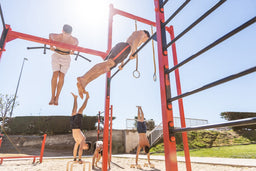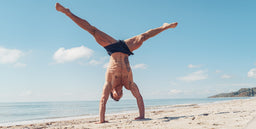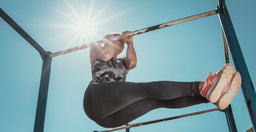
4 reasons to build a breathwork habit
4 reasons to build a breathwork habit
Breathwork is more than a passing trend – it’s a legit wellness practice that can improve training, recovery, and performance.
What is breathwork
Breathing is one of your body’s autonomic processes, and you’ve (obviously) been doing it continually since you were born. But that doesn’t necessarily mean you’re any good at it. In fact, our modern lifestyles make it pretty difficult to breathe optimally. All that stress and sitting down takes the focus away from diaphragmatic belly breathing and up into the chest where our breath gets shallow.
Breathwork is a fancy word for getting intentional with breathing. It’s nothing new, and it’s traditionally associated with yoga and meditation. But breathwork is moving into fitness and wellbeing circles with huge success.
4 benefits to doing breathwork
Almost-instant stress relief
Stress is a big problem for training and recovery. If you’re stressed going into a workout, or if training puts you into a state of stress, you’re not going to perform well. And if you constantly have a problem winding down, your recovery is going to be impacted. Learning a couple of basic breathwork exercises will help you manage stress, control nerves, and shift into the parasympathetic nervous system. (1)
Control cortisol
Stress doesn’t just feel horrible, it’s bad for your body. Cortisol, adrenalin, and other stress hormones keep your blood pressure raised and can eventually lead to poor heart health. And if body composition is your goal, stress makes it harder to lose fat. Breathing exercises tell your body it’s time to relax, lowering blood pressure without the need for medication. (2)
Positive mood and sharper focus
Breathwork isn’t just about learning to slow down. Certain breathwork exercises wake up your brain and body, helping you feel more energised, focused, and alert. Ideal if you struggle to transition into training mode after a long day at work. https://www.tcd.ie/news_events/articles/the-yogi-masters-were-right-breathing-exercises-can-sharpen-your-mind/
Buffer discomfort to train harder
Most of us are pretty good at pushing through fatigue in training, but anything that helps give us the edge is useful. Breathwork can help with pain management and perceived rate of exertion, making it a great tool to call on during high intensity workouts or competition. Studies show that slow breathing can reduce perception of discomfort (3) and even deal with back pain. (4)
How breathwork can improve training and recovery
A major study in 2011 found out that runners who did breathing exercises alongside their regular training for six weeks improved their running times by 5%-12%. (5) Amazing for a breathing bolt-on that costs absolutely nothing.
For strength athletes, functional fitness practitioners and calisthenics fans, regular breathwork is likely to impact stress, sleep, focus, and recovery. Sounds pretty good to us. Here’s how to get started.
The easiest way to start doing breathwork
The best known and easiest way to start your own breathwork practice is with diaphragmatic belly breathing. You can probably do it right now. The reason this works is because it forces you to breathe as nature intended, using your diaphragm and other rib muscles to take full breaths.
How to do diaphragmatic breathing
Most of us spend the majority of time taking shallow breaths into our upper chest. Breathing properly into the belly activates the parasympathetic (“rest and digest”) nervous system, slows the heart rate, and calms the mind.
Sit upright with your hands in your lap, or lie down with one hand on your chest and the other on your belly. Close your eyes and breathe in deeply through your nose. Feel the air expand your chest then your belly. Breathe out slowly from your belly then your chest. Aim for a count of 3 and 3 (or more). Repeat this for at least 10 full breaths – more if you can.
3 best breathing exercises for athletes
Box breathing
Sit upright with your hands in your lap. Exhale all the air from your lungs and hold for a 4-count. Then inhale through the nose for a 4-count. Hold your breath for a 4-count (try to stay relaxed). Then release the hold and exhale gently for a 4-count. Start with 1 minute and build up to a maximum of 5 minutes.
Box breathing will make you feel calm and grounded but not sleepy.
2-1-4-1 breathing
Sit upright with your hands in your lap. Inhale through the nose for 2 breaths. Pause at the top of the in-breath for 1 count. Exhale gently for a 4-count. Pause at the bottom of the exhale for 1 count.
This is a fast and easy way to relax or bring stress under control.
Alternate nostril breathing
Known as pranayama in yoga, this breathing technique helps you focus and get away from distractions, and it gets a ton of oxygen into the brain.
Sit upright, and bring your right hand up to your nose. Put your thumb over your right nostril and exhale slowly through the left nostril. Release the right nostril and cover your left nostril with your ring finger. Breathe in deeply and exhale through the right nostril. Uncover the left nostril and cover the right nostril again with your thumb and repeat the cycle. Do this 10 times.
1 https://www.ncbi.nlm.nih.gov/pmc/articles/PMC5455070/
2 https://pubmed.ncbi.nlm.nih.gov/11319675/
3 https://www.sciencedaily.com/releases/2010/01/100120163704.htm
4 https://pubmed.ncbi.nlm.nih.gov/27632818/
5 https://medicalxpress.com/news/2011-04-secret-weapon-sports.html









































